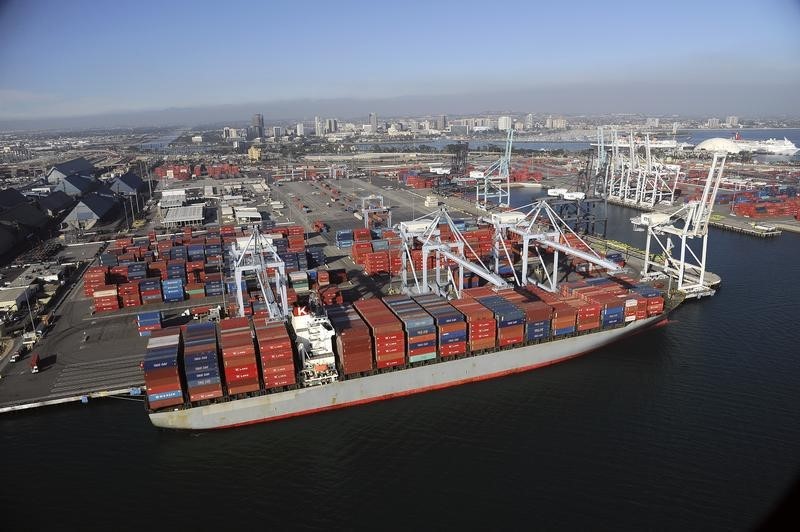Investing.com’s stocks of the week
By Lucia Mutikani
WASHINGTON (Reuters) - The U.S. trade deficit increased to a nine-month high in October due to rising oil prices and the widening of America's long-standing deficits with China and Mexico.
The worsening trade deficit came even as exports to China and Mexico were the strongest in more than three years, which some economists said challenged the Trump administration's argument that the United States was being disadvantaged in its dealings with trade partners.
"This leaves the Trump economics team empty handed when it comes to its mission to improve the unfair terms of trade which sent factories offshore starting a couple of decades ago," said Chris Rupkey, chief economist at MUFG in New York.
The Commerce Department said on Tuesday the trade gap widened 8.6 percent to $48.7 billion, the highest level since January. The politically sensitive U.S.-China trade deficit increased 1.7 percent to $35.2 billion and the deficit with Mexico surged 15.9 percent to $6.6 billion.
Economists polled by Reuters had forecast the overall trade deficit rising to $47.5 billion in October. U.S. financial markets were little moved by the large trade shortfall, which was flagged in an advance report last week.
Republican President Donald Trump has blamed the trade deficit for the massive loss of U.S. manufacturing jobs as well as moderate economic growth. Trump has ordered the renegotiation of the North American Free Trade Agreement (NAFTA), which was signed in 1994 by the United States, Canada and Mexico.
He told a group of pro-NAFTA Republican senators during lunch on Tuesday that the United States had trade deficits with "everybody."
"And that's going to be changing - it's already changing - but it's going to be changing fast," Trump said, adding that NAFTA negotiations were "going to be very successful."
NAFTA talks have stalled, with Mexico and Canada rejecting a U.S. proposal to raise the minimum threshold for autos to 85 percent North American content from 62.5 percent as well as to require half of vehicle content to be from the United States.
TRADE DRAG
When adjusted for inflation, the trade deficit increased to $65.3 billion, also the largest since January, from $62.2 billion in September. The so-called real trade deficit in October was above the third-quarter average of $62.0 billion, suggesting that trade could subtract from gross domestic product in the October-December quarter.
The government reported last month that trade contributed 0.43 percentage point to the economy's 3.3 percent annualized growth pace in the third quarter. The Trump administration believes a smaller trade deficit, together with deeper tax cuts could boost annual GDP growth to 3 percent on a sustained basis.
Republicans in the U.S. Congress have approved a broad package of tax cuts, including slashing the corporate income tax rate to 20 percent from 35 percent. But the planned fiscal stimulus will come at a time when the economy is at full employment, which will boost imports and widen the trade gap.
"While U.S. domestic demand will strengthen, foreign producers will supply an increased share," said Mickey Levy, chief economist Americas and Asia at Berenberg Capital Markets in New York. "We project the U.S. trade and current account deficits will widen."
Imports of goods and services increased 1.6 percent to a record $244.6 billion in October. Goods imports were the highest since May 2014 amid a $1.5 billion increase in crude oil imports. Imported oil prices averaged $47.26 per barrel in October, the highest since August 2015.
The country's import bill was also boosted by food imports, which were the highest on record. There were also increases in imports of cellphones and other goods. Imports from China and Mexico were the highest on record in October.
Exports of goods and services were unchanged at $195.9 billion in October as a surge in shipments of industrial supplies and petroleum was offset by sharp declines in and civilian aircraft exports.
Exports to China hit their highest level since December 2013, while those to Mexico were the highest in three years.
A separate report on Tuesday showed activity in the services sector slowed in November amid a sharp moderation in both new and export orders.
The Institute for Supply Management (ISM) said its non-manufacturing index fell to a reading of 57.4 last month from 60.1 in October. A reading above 50 in the ISM index indicates an expansion in the services sector, which accounts for more than two-thirds of the U.S. economy.
Last month, a gauge of new orders received by services industries dropped to 58.7 from a reading of 62.8 in October. A measure of new export orders fell 3.0 points while imports rose 0.5 point.
(This version of the story has been corrected to add dropped word in headline)
